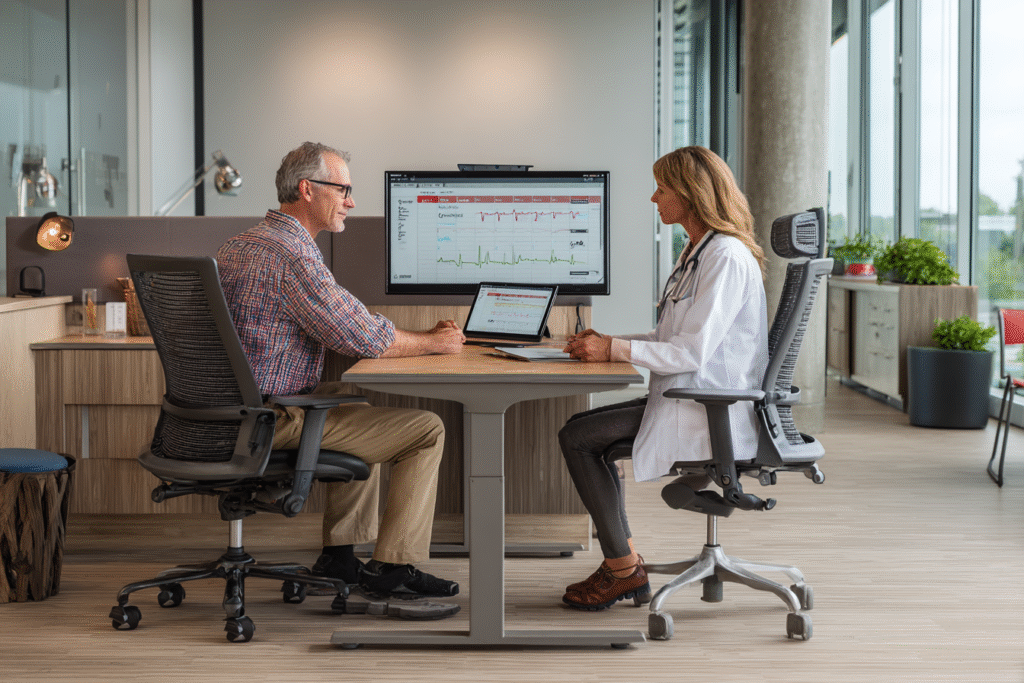The most powerful health intervention isn’t a drug or surgery—it’s catching problems while they’re still opportunities.
Note: This article is for educational and informational purposes only. See full disclaimer at the end.
Two hours. That’s all it takes to prevent decades of suffering—and save more than any investment you’ll ever make.
In our last insight, we talked about the staggering $6 trillion cost of waiting—the compound interest of health debt that accumulates when we avoid prevention.
Today, I’m delivering on the promise I made: a simple, personal health protocol that turns the economics in your favor.
The Two-Hour Investment That Pays Six-Figure Returns
Here’s what most people get wrong about health monitoring: they think it requires expensive tests, constant doctor visits, or complicated tracking systems. The reality is simpler—and more powerful.
Your personal health monitoring protocol takes approximately two hours to set up and two hours per year to maintain. Two hours. That’s it. That’s less time than most movies.
The payoff? Potentially preventing the kind of health crises that cost $50,000, $100,000, or more—both financially and in quality of life.
This isn’t another health tracking system. This is a strategic framework designed around one principle: catch problems while they’re still opportunities, not crises.

The Reality Architecture of Health Monitoring
Remember our Reality Architecture Protocol? It applies perfectly to health monitoring:
- Signal Detection: Your body constantly sends signals about your health status
- Pattern Recognition: Systematic monitoring reveals patterns invisible to casual observation
- Strategic Focus: Age-appropriate protocols maximize early detection while minimizing unnecessary testing
- Feedback Optimization: Regular monitoring creates a feedback loop for continuous health improvement
These principles form the foundation of effective health monitoring, but how do you actually implement them?
The answer lies in a strategic, age-based approach that recognizes that your health risks and monitoring needs evolve throughout your life.
Your Age-Stratified Monitoring Framework
Evidence from systematic reviews shows that age-appropriate, risk-stratified screening protocols provide the optimal balance between early detection benefits and over-testing harms [9]. The key is implementing evidence-based guidelines that reflect both population-level data and individual risk factors [10].
Universal Monitoring: The Foundational Five
These five foundational monitors apply to all adults, forming the universal core of your protocol:
Annual Physical Examination
- Complete health assessment with trusted primary care provider
- Baseline vital signs, weight, BMI
- Review of medications, supplements, lifestyle factors
- Discussion of family history updates and risk factor changes
Blood Pressure Monitoring
- Annual minimum, quarterly if elevated
- Home monitoring capability for those with hypertension risk
- Target: Below 130/80 mmHg for most adults
Basic Metabolic Panel
- Annual blood work including glucose, lipids, kidney function
- Establishes baseline and tracks changes over time
- Earlier diabetes detection, cardiovascular risk assessment
Mental Health Check-ins
- Annual assessment of mood, stress levels, sleep quality
- Screening for depression, anxiety, substance use
- Acknowledges the profound impact of mental health on physical well-being
Family History Updates

Your 20s: Building the Foundation (Ages 20-29)
Your twenties represent a unique opportunity in health monitoring – you’re establishing the baseline measurements and habits that will serve you for decades to come. During this period, the monitoring approach is deliberately minimal but strategically important.
The foundation involves annual physical examinations where you establish relationships with healthcare providers and begin building comprehensive health records. Blood pressure should be checked annually, providing crucial baseline information for future comparison. A basic lipid panel every five years, starting between ages 20-25, begins the important work of cardiovascular risk assessment. STI screening based on your sexual activity and risk factors remains an important component of comprehensive care, along with annual mental health assessments for mood, stress levels, and sleep quality.
For women in their twenties, cervical cancer screening begins at age 21 with Pap tests every three years, representing one of the first major cancer prevention protocols. Annual well-woman exams provide opportunities for reproductive health discussions and family planning conversations. Rather than formal breast self-exams (which are no longer recommended), the focus shifts to breast self-awareness and understanding normal changes.
Men in their twenties benefit from testicular self-awareness education, though formal self-exams are no longer routinely recommended. Sexual health discussions and STI prevention become important components of annual visits.
The key insight for this decade is that you’re building the foundation for everything that comes later. Establishing strong relationships with healthcare providers, creating comprehensive health records, and developing sustainable healthy lifestyle patterns sets the stage for more sophisticated monitoring as health risks evolve.
Your 30s: Early Detection Begins (Ages 30-39)
The thirties introduce the first major screening protocols as certain health risks begin to emerge. This decade marks the transition from pure prevention to early detection strategies.
Enhanced monitoring builds on your established foundation with increased sophistication. Blood pressure checks remain annual, with more frequent monitoring if readings are elevated. Diabetes screening with A1C or fasting glucose every three years becomes important if risk factors are present. Cholesterol screening every five years continues, with more frequent testing if abnormal results emerge. Annual skin assessment for skin cancer risk and eye exams every 2-4 years join the monitoring protocol.
For women, cervical cancer screening options expand significantly. You can choose Pap tests every three years, HPV testing every five years, or co-testing every five years, depending on your risk factors and preferences. Breast cancer risk assessment becomes important, especially if family history suggests elevated risk. For those planning pregnancy, preconception counseling provides valuable health optimization opportunities. Bone density consideration may begin if risk factors like family history, medications, or medical conditions suggest increased fracture risk.
Men in their thirties should begin discussions about future prostate screening, particularly if family history suggests elevated risk. The focus on cardiovascular risk factor modification intensifies, with attention to diet, exercise, stress management, and other modifiable factors.
The key insight for the thirties is transitioning from prevention to early detection while optimizing all modifiable risk factors. This decade establishes the screening patterns that will intensify in later years.

Your 40s: Strategic Screening Intensifies (Ages 40-49)
The forties mark a significant shift in your health monitoring approach. This decade introduces the first major cancer screening protocols while intensifying focus on cardiovascular health and chronic disease prevention.
Building on your established foundation, all previous monitoring continues but with increased frequency and sophistication. Blood pressure monitoring becomes annual at minimum, with more frequent checks if readings are elevated. Diabetes screening every three years becomes important for those with risk factors, while cholesterol monitoring every five years (or more often if abnormal) helps track cardiovascular health trends. Eye exams every 2-4 years and annual skin cancer assessment for those with risk factors round out the expanded monitoring approach.
For women, this decade brings the introduction of breast cancer screening – one of the most significant additions to the monitoring protocol. Annual mammograms typically begin between ages 40-50, with the exact timing determined through discussions with healthcare providers based on individual risk factors [11]. Research consistently shows that mammography screening reduces fatal breast cancers by 34-49% among participants [3][4]. Cervical cancer screening continues according to established protocols, while bone density screening may begin if risk factors are present. Cardiovascular risk assessment becomes increasingly important as estrogen protection begins to decline.
Men in their forties should begin conversations about prostate cancer screening, though formal testing typically doesn’t start until age 50 unless high-risk factors are present. The focus intensifies on cardiovascular health monitoring, including discussions about testosterone levels if symptoms are present.
A major consideration during this decade involves colorectal cancer screening, which may begin at age 45 for average-risk individuals according to newer guidelines [9]. For those with family history, screening often begins earlier. The effectiveness of colonoscopy screening is well-established, with research showing it reduces colorectal cancer mortality by 21% and distal cancer deaths by up to 59% [5][6]. Options include colonoscopy every 10 years, annual stool tests, or other approved methods [11].
The critical insight for the forties is learning to balance early detection with over-testing. This decade requires customizing your approach based on individual and family risk factors while avoiding unnecessary anxiety or diagnostic overreach.
Your 50s: Peak Screening Years (Ages 50-59)
The fifties represent the peak years for health screening, when most major cancer and chronic disease monitoring protocols reach full implementation. This decade requires sophisticated coordination of multiple screening modalities while maintaining focus on prevention and early detection.
All previous monitoring continues with enhanced frequency and attention to emerging health patterns. Blood pressure monitoring becomes even more critical, with annual checks at minimum and more frequent monitoring for those with elevated readings. Diabetes screening every three years remains important for those with risk factors, while cholesterol monitoring every five years continues unless more frequent testing is indicated. Annual eye exams become standard, as does annual skin cancer screening for those with risk factors.
Universal cancer screening reaches full implementation during this decade. Colorectal cancer screening becomes essential for everyone, with research showing significant mortality reduction through systematic screening programs [7][8]. Options include colonoscopy every 10 years, annual stool tests, or other approved methods, with the choice often depending on individual preference and risk factors. For those with significant smoking history, lung cancer screening with annual low-dose CT becomes important for individuals with 20+ pack-year history who currently smoke or quit within 15 years [9].
Women continue annual mammograms with increasing attention to breast density and family history factors. Cervical cancer screening continues per established protocols until age 65 for most women. Osteoporosis screening with DEXA scans may begin at age 50 if risk factors are present, while cardiovascular risk assessment becomes increasingly sophisticated as menopause approaches or occurs.
Men typically begin formal prostate cancer screening discussions, with shared decision-making about PSA testing and digital rectal exams. For those with smoking history, abdominal aortic aneurysm screening may be considered, while testosterone evaluation becomes relevant if symptoms suggest deficiency.
The key insight for the fifties is implementing full evidence-based screening while avoiding over-testing. This requires managing multiple health priorities simultaneously and working closely with healthcare providers to coordinate care effectively.

Your 60s and Beyond: Wisdom-Based Monitoring (Ages 60+)
Entering your sixties and beyond brings a shift from aggressive screening to wisdom-based monitoring that balances longevity with quality of life. The focus evolves from detecting every possible condition to managing established health issues while preventing complications that could significantly impact your daily functioning.
All appropriate screening continues based on your life expectancy and overall health status, but the approach becomes more personalized and thoughtful. Monitoring for established conditions becomes more frequent, while new screening decisions follow realistic benefit-risk calculations. Fall risk assessment and prevention strategies become crucial new additions, as does comprehensive medication review and management to prevent adverse interactions. Cognitive health assessment joins the monitoring protocol, providing early detection of memory changes that could benefit from intervention.
Several age-specific additions become important during this period. Bone density screening with DEXA scans becomes routine for women 65 and older, and for men with risk factors, typically repeated every two years. Men aged 65-75 with smoking history should receive one-time abdominal aortic aneurysm screening with ultrasound. Vaccination updates become increasingly important, including shingles vaccines, pneumonia vaccines, and annual flu shots, as immune function naturally declines with age.
Enhanced fall prevention measures take on new significance, including balance assessments, home safety evaluations, and vision optimization. These interventions can prevent injuries that often trigger rapid health decline in older adults.
Some screening modifications may be appropriate based on life expectancy and overall health status. Certain cancer screenings might be discontinued when the potential harms outweigh benefits, while increased focus shifts to quality of life and functional status. The emphasis moves toward managing multiple chronic conditions effectively rather than searching for new ones.
The critical insight for this life stage involves transitioning from aggressive screening to quality-of-life optimization. The goal becomes balancing longevity with meaningful life, maintaining independence and function while preventing complications that could significantly impact daily activities.
Having a comprehensive monitoring framework tailored to your life stage is essential, but knowing what to monitor is only half the equation. The other half is building the systems and partnerships that make your monitoring protocol actually work in real life.
You’ve spent decades building the system. This is where it really pays off.
The Four Foundations of Implementation
The difference between having a monitoring protocol and actually using one effectively comes down to four essential foundations. Think of these as the supporting structure that makes your entire health monitoring system work seamlessly.

Foundation 1: Documentation Strategy
Creating a health monitoring system without proper documentation is like building a house without blueprints. You need a single, organized approach to tracking all your health information that grows with you over time.
The cornerstone of effective monitoring is your Health Monitoring Dashboard—a single document or digital file that tracks all screening dates, sets automated reminders, summarizes results in plain language, and becomes your personal health command center.
Most importantly, this dashboard should be accessible to family members for continuity and updated after every medical visit.
Your dashboard should contain essential information: last screening dates for all age-appropriate tests, any abnormal results with follow-up actions taken, family history updates, including new diagnoses, medication changes (including adverse reactions), and key baseline trends like weight and blood pressure.
This documentation becomes invaluable during emergencies and ensures nothing falls through the cracks.
Foundation 2: Provider Partnership
The most sophisticated monitoring protocol is worthless without the right healthcare team to help you implement it. This means establishing a primary care relationship that goes beyond just having someone to call when you’re sick.
Your primary care relationship should be built on consistency – working with a provider who knows your history, risk factors, and health goals. This requires annual visits minimum, with more frequent appointments if your health status indicates [12]. The relationship thrives on clear communication about your screening preferences, health goals, and any concerns about recommended protocols.
The most effective approach involves collaborative decision-making about test timing and frequency based on evidence-based guidelines [9]. This means your provider explains the reasoning behind recommendations, discusses alternatives when appropriate, and respects your informed decisions about your health care.
Specialist integration becomes crucial as your monitoring reveals areas needing expert attention. Your primary care provider should coordinate appropriate referrals based on screening results or risk factors, ensure communication between all providers for comprehensive care, and maintain regular updates about findings and recommendations across your entire care team.

Foundation 3: Risk Stratification
Not everyone needs the same monitoring protocol. The key to effective health monitoring is understanding your unique risk profile and adjusting your approach accordingly.
Family history integration forms the backbone of personalized monitoring. This means developing a three-generation family health history for major conditions, adjusting screening timelines based on family patterns, considering genetic counseling for high-risk families, and maintaining regular updates as new family diagnoses emerge [14][15].
Personal risk factor assessment goes beyond genetics to include lifestyle factors like smoking, diet, exercise habits, and stress management approaches. Environmental exposures and occupational risks also matter, as does your previous health history and any chronic conditions. Even medication history and potential drug interactions play a role in determining your optimal monitoring strategy.
Foundation 4: Technology Integration
Technology should enhance your monitoring system, not complicate it. The goal is to use smart tools that make tracking easier and more effective while maintaining the human relationships that matter most.
Smart monitoring tools can include home blood pressure monitoring when indicated, wearable devices for activity and sleep tracking (though these should remain optional), health apps for medication reminders and appointment scheduling, and electronic health records access for tracking results. Choose tools that genuinely support your goals—without creating technology overwhelm.
Consistency beats sophistication—a simple system you actually use is better than a complex one you abandon. Most importantly, ensure technology supports rather than replaces your provider relationships.
Now that you understand the foundational elements that make monitoring systems work, let’s turn these concepts into action. The key is breaking down what might seem like an overwhelming process into manageable, sequential steps.
Technology should extend your awareness—not replace your responsibility.
Let’s imagine Jasmine. A 37-year-old freelance designer with a packed schedule and a history of brushing off routine checkups. She hasn’t had bloodwork in four years, assumes she’s “fine,” and finds the idea of organizing health records overwhelming.
But after losing a close friend to late-detected cancer, Jasmine decided to spend one Sunday afternoon building her personal health dashboard. She booked her annual physical, mapped out overdue screenings with her provider, and now uses her phone’s calendar to track reminders.
The result? A two-hour investment that gave her peace of mind—and a clear, personalized protocol she can follow every year with minimal friction.

Your Implementation Protocol
Implementing a comprehensive health monitoring protocol might seem overwhelming, but breaking it down into a systematic four-week approach makes it manageable and sustainable. Each week builds on the previous one, creating momentum toward a fully functional monitoring system.
Week 1: Foundation Setup
The first week focuses on gathering and organizing all your existing health information. Begin by collecting all available medical records, creating a comprehensive family health history document, and listing current medications and supplements with dosages. If you don’t currently have a primary care provider, use this week to research options in your area and check insurance coverage.
Simultaneously, complete your initial risk assessment using reliable online tools like the CDC Family Health History tool or the American Heart Association’s Heart Risk calculator. Have conversations with family members to research your family medical history thoroughly, paying special attention to major risk factors and genetic predispositions. By the end of week one, you should have a clear picture of your current health status and risk profile.
Week 2: Baseline Establishment
Week two centers around your comprehensive provider visit and establishing baseline measurements. Schedule and complete your annual physical examination, using this appointment to discuss your family history and personal risk factors with your healthcare provider. Work together to establish baseline measurements and order appropriate screening tests based on your age and risk factors.
Use this visit to create a personalized screening schedule for the next one to three years, ensuring you understand the reasoning behind each recommendation. Schedule all recommended follow-up appointments before you leave the office, and set up calendar reminders for future screening dates. Share relevant information with family members who might benefit from knowing about hereditary risk factors.

Week 3: System Optimization
The third week involves integrating technology and optimizing your monitoring system for long-term success. Set up any recommended home monitoring equipment, such as blood pressure cuffs or glucose meters. Download relevant health apps like Apple Health, MyChart, Medisafe, or access your healthcare provider’s patient portal for easy access to results and communication.
Create secure backups of all your health information, either digitally or in physical files that family members can access in emergencies. Establish a routine for regular health data review, whether weekly, monthly, or quarterly depending on your needs. Connect with appropriate support systems or resources, such as disease-specific organizations if you have chronic conditions.
Week 4: Long-term Planning
The final week focuses on creating sustainable systems for ongoing success. Review and adjust your monitoring schedule based on provider recommendations and your personal preferences. Set an annual review date for protocol updates, ensuring your approach evolves as guidelines change and your health status shifts.
Plan for regular family history updates as new diagnoses emerge in your extended family. Create emergency contact lists and ensure family members know how to access your health information if needed. Most importantly, document baseline measurements and establish target goals, creating metrics for measuring your protocol’s success over time.
This systematic approach transforms health monitoring from an overwhelming concept into a manageable reality. But understanding the implementation process is only part of the equation—it’s equally important to understand why this investment makes financial sense.
You’ve built the protocol, established your foundation—now it’s time to understand why this investment isn’t just good for your health. It’s good for your bottom line.

The Economic Return: Your Health Investment Portfolio
Think of your monitoring protocol as a diversified investment portfolio:
Low-Cost, High-Frequency Monitoring (Blood pressure, weight, basic labs)
- Minimal cost, maximum early detection potential
- Identifies trends before they become problems [12]
- Enables lifestyle interventions before medical treatment needed
Moderate-Cost, Medium-Frequency Screening (Annual physical, routine cancer screening)
- Evidence-based tests with proven mortality reduction [3][4][5]
- Cost-effective when timed appropriately
- Balances early detection with over-testing risks [7]
Higher-Cost, Lower-Frequency Testing (Advanced imaging, genetic testing)
- Reserved for high-risk individuals or specific clinical indications
- Provides detailed information when simpler tests suggest problems
- Prevents unnecessary testing while ensuring appropriate care
Return on Investment:
- Preventive health programs show return on investment ratios from 125% to 3900% [1]
- Every $1 invested in preventive care—screenings, chronic disease management, or lifestyle support—can return $3–7 in health care savings within 2–3 years [2]
- Mammography screening reduces fatal breast cancers by 34-49% among participants [3]
- Colonoscopy screening prevents colorectal cancer deaths by 21% and reduces mortality by up to 59% [5]
- Quality of life preservation has immeasurable value beyond financial considerations
While ROI analysis provides valuable insights for health program justification, these calculations involve inherent complexities and assumptions that should be understood when making health investment decisions [13].
For Jasmine, what began as a Sunday reset turned into a system she updates once a year with ease, uses with confidence—and delivers excellent returns.

Common Implementation Challenges and Solutions
Challenge: “I Don’t Have Time”
Reality Check: Two hours annually vs. weeks or months managing a health crisis
Solution: Schedule screening as non-negotiable appointments, batch similar tests, use provider networks efficiently
Challenge: “It’s Too Expensive”
Reality Check: Most preventive services are covered by insurance at 100% under the Affordable Care Act [9]
Solution: Understand insurance benefits, use in-network providers, prioritize highest-yield screening based on evidence [1][2]
Challenge: “I’m Healthy, I Don’t Need This”
Reality Check: Health problems often develop silently over years or decades
Solution: Focus on maintaining health rather than finding disease, view as insurance policy
Challenge: “My Doctor Doesn’t Recommend This Schedule”
Reality Check: Guidelines vary, and evidence-based recommendations continue to evolve [9][12]
Solution: Discuss evidence behind recommendations, seek second opinion if needed, find provider aligned with your prevention philosophy
Challenge: “Too Many Tests, Too Confusing”
Reality Check: Systematic approach reduces complexity and missed opportunities
Solution: Use this framework as starting point, customize based on your specific risks and preferences
While these challenges are real, they’re all solvable with the right approach and mindset. The key is viewing your monitoring protocol not as a burden, but as a strategic investment in your most valuable asset—your health.

Tomorrow's Next Steps
The monitoring protocol we’ve designed today represents something much more powerful than a to-do list of medical tests. It’s a strategic framework for transforming your relationship with your health from reactive to proactive, from crisis management to opportunity optimization.
But having a protocol isn’t enough. Tomorrow, we’ll address the elephant in the room: making prevention accessible regardless of your economic situation. We’ll explore cost-effective health optimization strategies that work within any budget, from basic insurance plans to paying out of pocket.
Because health optimization shouldn’t be a luxury good available only to those with premium insurance and unlimited resources. It should be a systematic approach available to anyone willing to invest the time and intention.
Your monitoring protocol is your early warning system.
You don’t have to live in fear of what might happen. You can build a system that sees it coming—and gives you enough time to act.
See you in the next insight.
Comprehensive Medical Disclaimer: The insights, frameworks, and recommendations shared in this article are for educational and informational purposes only. They represent a synthesis of research, technology applications, and personal optimization strategies, not medical advice. Individual health needs vary significantly, and what works for one person may not be appropriate for another. Always consult with qualified healthcare professionals before making any significant changes to your lifestyle, nutrition, exercise routine, supplement regimen, or medical treatments. This content does not replace professional medical diagnosis, treatment, or care. If you have specific health concerns or conditions, seek guidance from licensed healthcare practitioners familiar with your individual circumstances.
References
The references below are organized by study type. Peer-reviewed research provides the primary evidence base, while systematic reviews synthesize findings across multiple studies for broader perspective.
Peer-Reviewed / Academic Sources
- [1] Masters, R., Anwar, E., Collins, B., et al. (2017). Return on investment of public health interventions: a systematic review. J Epidemiol Community Health. 71(8):827-834. https://pmc.ncbi.nlm.nih.gov/articles/PMC5537512/
- [2] Musich, S., Wang, S.S., Klemes, A., et al. (2016). The impact of personalized preventive care on health care quality, utilization, and expenditures. Popul Health Manag. 19(6):389-397. https://pmc.ncbi.nlm.nih.gov/articles/PMC5296930/
- [3] Duffy, S.W., Tabár, L., Yen, A.M.F., et al. (2020). Mammography screening reduces rates of advanced and fatal breast cancers: Results in 549,091 women. Cancer. 126(13):2971-2979. https://acsjournals.onlinelibrary.wiley.com/doi/10.1002/cncr.32859
- [4] Tabár, L., Dean, P.B., Chen, T.H.H., et al. (2021). Beneficial effect of consecutive screening mammography examinations on mortality from breast cancer: a prospective study. Radiology. 299(3):541-547. https://pubs.rsna.org/doi/full/10.1148/radiol.2021203935
- [5] Bretthauer, M., Løberg, M., Wieszczy, P., et al. (2022). Effect of colonoscopy screening on risks of colorectal cancer and related death. N Engl J Med. 387(17):1547-1556. https://www.nejm.org/doi/full/10.1056/NEJMoa2208375
- [6] Selby, J.V., Friedman, G.D., Quesenberry, C.P. Jr., Weiss, N.S. (1992). A case-control study of screening sigmoidoscopy and mortality from colorectal cancer. N Engl J Med. 326(10):653-657. https://pubmed.ncbi.nlm.nih.gov/1736103/
- [7] Knudsen, A.B., Zauber, A.G., Rutter, C.M., et al. (2016). Estimation of benefits, burden, and harms of colorectal cancer screening strategies: modeling study for the US Preventive Services Task Force. JAMA. 315(23):2595-2609. https://pubmed.ncbi.nlm.nih.gov/27305518/
- [8] Binefa, G., Rodríguez-Moranta, F., Teule, A., Medina-Hayas, M. (2014). Colorectal cancer: from prevention to personalized medicine. World J Gastroenterol. 20(22):6786-6808. https://pmc.ncbi.nlm.nih.gov/articles/PMC4051918/
Government / Institutional Sources
- [9] U.S. Preventive Services Task Force. (2025). A and B Recommendations. Available at: https://www.uspreventiveservicestaskforce.org/uspstf/recommendation-topics/uspstf-a-and-b-recommendations
- [10] Centers for Disease Control and Prevention. (2024). Family Health History and Adults. Available at: https://www.cdc.gov/family-health-history/family-health-history-and-you/family-health-history-and-adults.html
- [11] UCLA Health. (2025). Wellness & Annual Health Screenings. Available at: https://www.uclahealth.org/patient-resources/support-information/patient-education/annual-health-wellness-screenings
- [12] Canadian Task Force on Preventive Health Care. (2023). Periodic Preventive Health Visits. Available at: https://canadiantaskforce.ca/guidelines/periodic-preventive-health-visits/
Industry / Technology Sources
- [13] Brousselle, A., Laurendeau, M.-C. (2016). What are the benefits and risks of using return on investment to defend public health programs? Prev Chronic Dis. 13:E03. https://pmc.ncbi.nlm.nih.gov/articles/PMC4929139/
- [14] ACOG Committee. (2011). Family history as a risk assessment tool. Obstet Gynecol. 117(3):747-750. https://pubmed.ncbi.nlm.nih.gov/21343792/
- [15] Wu, R.R., Orlando, L.A., Himmel, T.L., et al. (2013). Patient and primary care provider experience using a family health history collection, risk stratification, and clinical decision support tool: a type 2 hybrid controlled implementation-effectiveness trial. BMC Fam Pract. 14:111. https://pubmed.ncbi.nlm.nih.gov/23915256/


